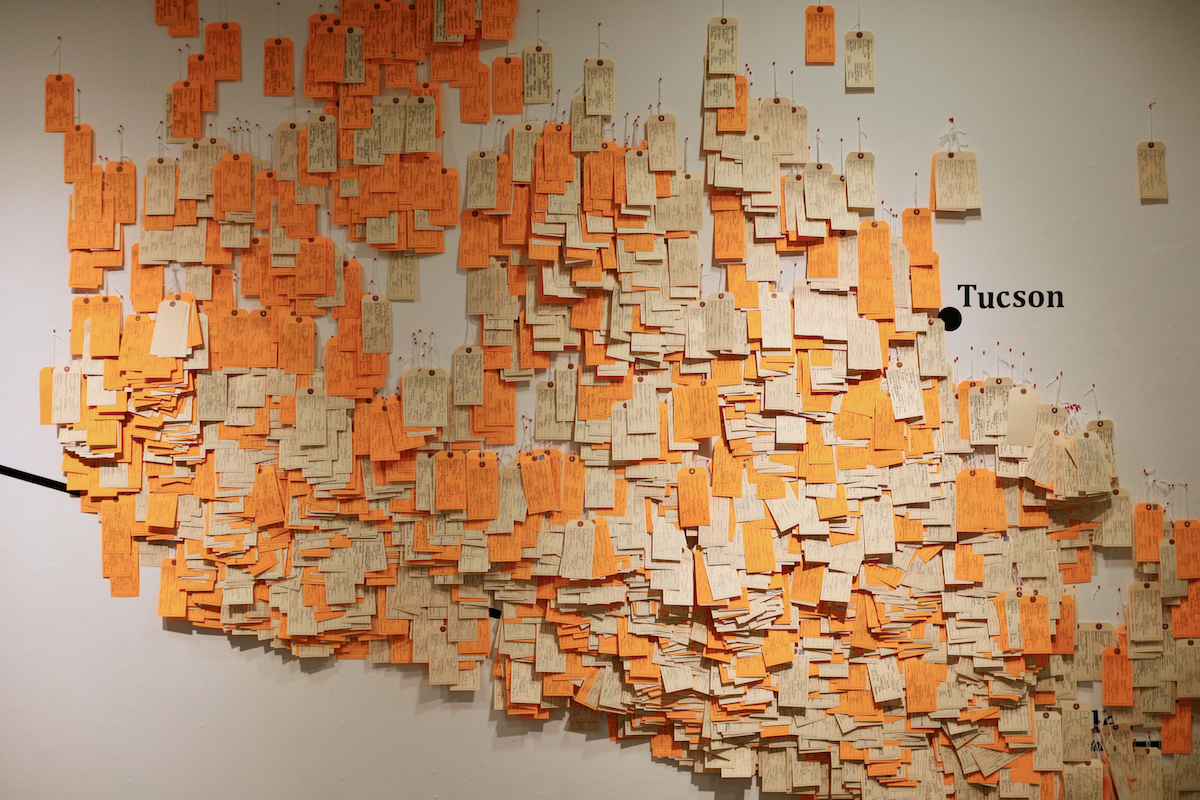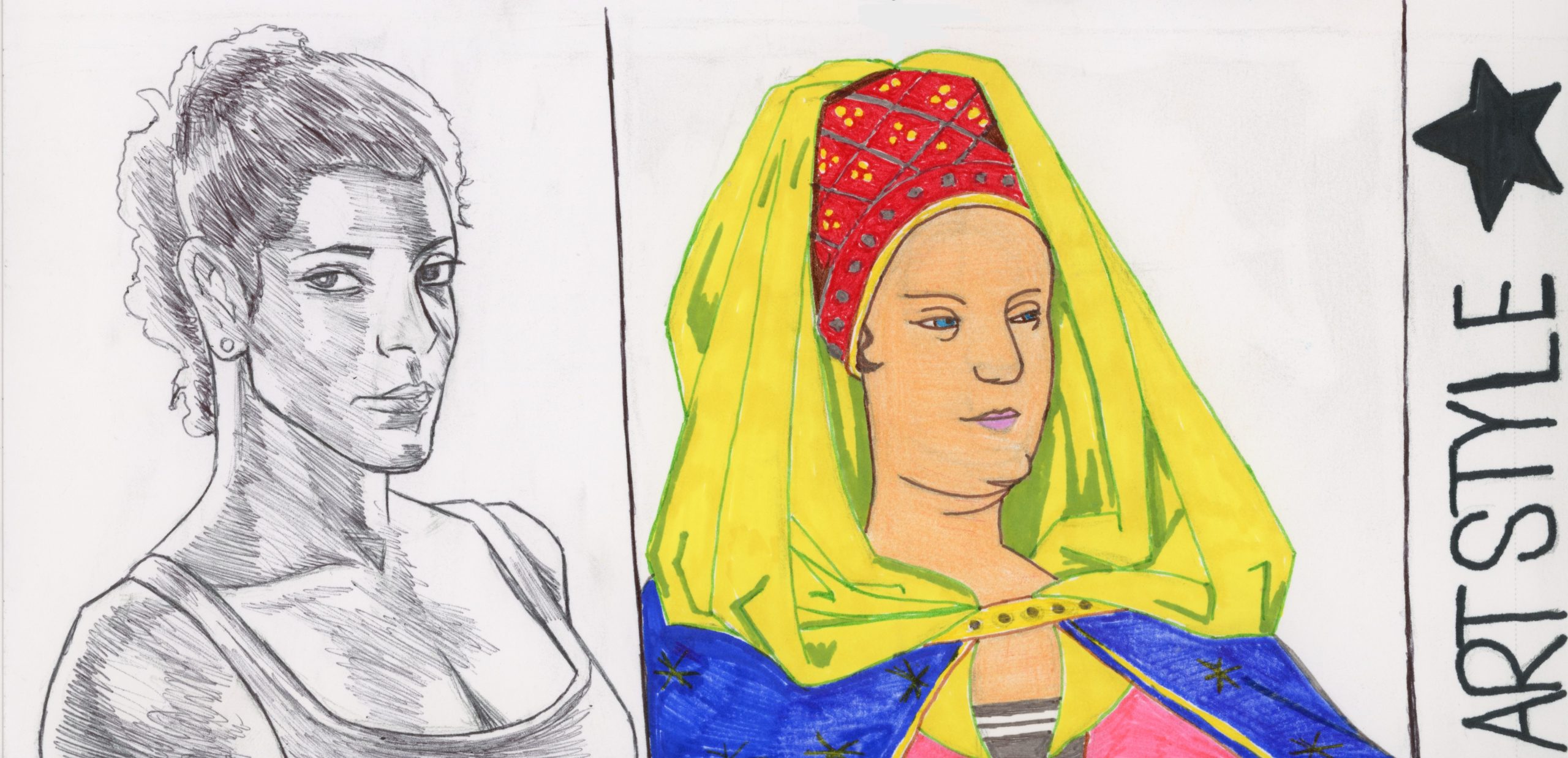Hostile Terrain 94 (HT94), the current exhibit at Portland State’s White Gallery, is a somber, collaborative work which stretches the entire width of the gallery’s wall from floor to ceiling. The artwork is a topographical map of the grave human cost of “prevention through deterrence,” a United States Border Patrol (USBP) strategy started by the Clinton administration that continues today.
The map is marked by toe tags illustrating places where migrants died as a result of the “prevention through deterrence” policy. Aimed at reducing immigration to the U.S. by forcing migrants into hostile terrain, the policy is an explicit effort to raise the level of risk for those attempting to enter.
Associate Professor of Anthropology at PSU, Mrinalini Tankha, helped host the exhibit.
“The exhibit is making us bear witness to this humanitarian crisis that’s happening,” Tankha said.
The HT94 project was started in 2019 by the Undocumented Migration Project (UMP), a long-term anthropological research organization seeking to uncover how the border environment was transformed through infrastructure and resource extraction, while centering the stories of the Indigenous and migrant communities most affected. One cruel feature of USBP policy is that it makes invisible those who bear the brunt of its slow violence.
More than 3,200 people are confirmed to have died trying to cross the Sonoran Desert into the U.S. Since the strategy was employed in the early ‘90s, countless others have gone missing. The Sonoran Desert is 120,000 square miles of land in both Mexico and the U.S., and the busy Tucson Sector runs 262 miles across the southern border of Arizona—a highly dangerous trek given the environmental conditions and risk of apprehension or vigilante violence.
HT94 organizers created the map from data collected by the UMP and the Colibrí Center for Human Rights to create a list of each deceased person’s identity, the exact location of their death and the cause of death—most commonly hyperthermia, dehydration, blunt force trauma or gunshot wounds. That information was then handwritten onto 3,200 toe tags and pinned to the precise geographic coordinate that correlates with where the body was found.
Roughly two-thirds of the tags are beige, representing people who were found and identified. The remaining orange tags represent those who were found but not identified.
“This is not something that the public sees,” Tankha said. “The exhibit is really trying to draw attention, to mobilize public support against this horrifying policy.”
The HT94 exhibit was intended to run simultaneously in U.S. cities before the 2020 election, before the COVID-19 pandemic disrupted plans and most galleries were forced to reschedule.
“It had a specific political agenda of mobilizing people, of making people aware of this tragedy that’s happening, that one doesn’t necessarily see otherwise,” Tankha said.
While this particular USBP strategy was in effect during the Trump administration, it is not a strictly partisan issue. The same strategy has been utilized under all Democratic and Republican administrations since 1994, including the current one.

The collaborative nature of the exhibit is an important part of raising awareness and personalizing the often-overlooked human toll of U.S. border policy. All data on the toe tags were handwritten by PSU students and faculty, as well as other volunteers. In the weeks leading up to the opening, some participants stayed into the early hours of the morning to finish installing the work in time.
“When helping fill out the tags, I was struck by the sterile language of death,” said Jennifer Martinez-Medina, a Public Affairs and Policy PhD candidate at PSU. “I ran across one person who passed due to exposure. I immediately thought of farmworkers who often die from pesticide and heat exposure. During the pandemic, farmworkers were labeled essential, and were disproportionately exposed to COVID-19. Many died. I wondered if their death certificates also read exposure.”
“Even for someone living and growing up in the area, the true magnitude of the crisis was completely hidden and obscured from view,” said Chris Rogers, a master’s student in the PSU anthropology department, who grew up 60 miles from the Mexican border in Tucson, AZ. “Commemorating these individuals in a way that brings awareness and respect to the sacrifice they made in pursuit of a better life was an important, albeit small, contribution that I am honored to have been a part of.”
At the exhibit’s opening on April 20, 2022, students and faculty bore testimony to their experience both with the project and with U.S. immigration. The White Gallery was adorned with papel picado hanging from support beams, and featured a variety of pan dulce, sage and a small ofrenda—the traditional, Mexican altar space created to celebrate late relatives during Día de los Muertos celebrations.
During the opening, PSU student and McNair Scholar, Daniela Ortiz Mendez, read an emotional poem she wrote in Spanish titled “Norte es Muerte,” told from the perspective of someone who passed away while trying to cross the border.
“In the U.S., death is not talked about—the culture here is not as comfortable with death,” Ortiz Mendez said. “I wanted it to be tied into death because people don’t make it across—that’s the reality. That’s why this project exists.”
Ortiz Mendez said that she hopes the exhibit will spark curiosity in the people who see it, and that they will begin to ask questions about the longstanding prevention through deterrence policy.
“This is still actively killing people,” Ortiz Mendez said. “You know, I’m not sure what it takes for people to recognize that these are just people trying to get a better life and they don’t deserve death.”
Her family moved to the U.S. from Tijuana in 1998 through the San Ysidro border crossing, in search of a better education and safer neighborhoods where her and her cousins could pursue what they wanted in life.
“At the end of the day, they just wanted us to be able to live a happier life,” Ortiz Mendez said. “I think that resonates with everybody—everybody just wants a better life.”






